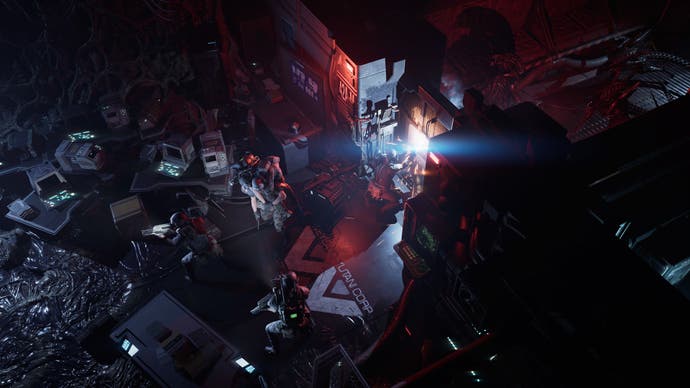Can a strategy game be horrifying?
Command and quiver.
Here's a question for all you armchair General Pattons and Joan of Arcs: has a tactics or strategy game ever made you jump? I've been thinking about this a lot while playing Tindalos Interactive's promising movie adaptation Aliens: Dark Descent, out next week on console and PC, in which you guide a quartet of gung-ho yet fragile troopers around xeno-infested bases, tracking down survivors and trying not to wake the full wrath of the Hive.
The problem with Aliens adaptations at large is that most horror fans know the 1986 film back-to-front, and are therefore immune to its scares, however creatively reimagined. You certainly wouldn't expect a top-down squad management sim to rekindle the frenzy and claustrophobia of that first-act battle beneath the atmosphere processing station - what Lieutenant Gorman would have given for a top-down view, to say nothing of a slow-mo command interface! But I've felt genuine fear at times while playing Aliens: Dark Descent, thanks to rather than in spite of its elevated perspective. On the basis of an hour's playtime, at least, it's a solid test-case for the idea that strategy games can make for gripping horror experiences, precisely because the two genres seem to have nothing in common.
"Strategy and tactics" covers a massive range, of course - real-time, turn-based, combat-focussed, economy-focussed, historical, sci-fi, Wholesome, grimdark, etc - but the throughline, perhaps, is that all these games hinge on a fantasy of control by means of distance, of having a world laid at your feet, so that you can safely and securely pop down pieces, pluck up resources, slice and redraw boundaries. Most horror games are the opposite: they trade in the feeling that the world is invading you, that you can't wield control over it because you can't separate yourself from it. A horror strategy game is therefore tantamount to a submarine on wheels. But that very incompatibility is a great setup for a scare.
Most horror developers want you to enjoy moments of feeling like you're on top of things, if not literally viewing them from above, so they can whip the carpet from under you. And while I'm not sure any strategy or tactics game studio has ever pushed it that far, there are many strategy or tactics game conventions that threaten similarly to tumble you from the role of godlike planner into the shoes of poor, hapless Gorman, panicking at banks of helmetcam monitors that only amplify his confusion. For instance, I will always be unnerved by "fog of war". This feature has taken various guises over the years, but it broadly refers to the cloud of unmapped nothing outside the areas your units have explored. It's the cowl thrown over your opponent's actions that must be carefully lifted away in the early game, while trying to keep your own agenda and units hidden. A classic videogame wrinkle - and an enduring source of dread.
As a rule, the fog of war blocks out everything. But in some games, it leaves you in limbo between seeing and not-seeing, able to scry the layout, perhaps, but not enemies. In Aliens: Dark Descent, the fog of war is a half-solid mass of boxy contours and clutter, gingerly sliced open by advancing torch beams. It gives you a workable idea of each building's interior - you can usually glean the rough locations of objectives and, most importantly, exits - but not so much that you'll always take the safest or shortest route, with rooms sardine-canned together so that you often pick the wrong door, and improvised barricades hidden in the gloom that must be back-tracked around, or exploded at the cost of alerting anything lurking nearby.
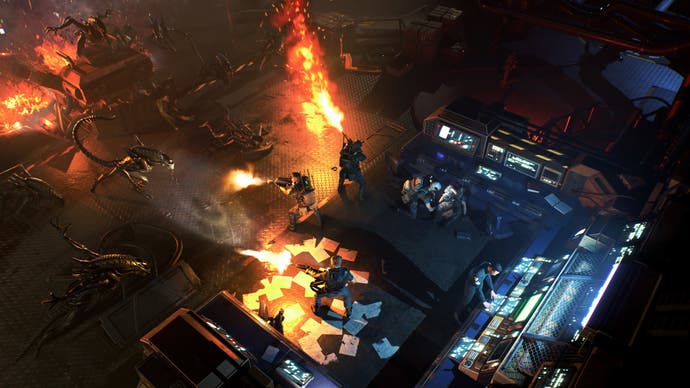
While it's quite a bald work of Alien canon - there's a bestiary, with categories of xenomorph pegged out in deflating military jargon - Dark Descent also seems to understand the importance of technological mediation when it comes to constructing the horror of the Alien. It knows that however familiar the Alien has become, it's always pretty alarming when portrayed as a moving dot on your motion tracker that maps ambiguously to the surrounding architecture.
The game leans into that anxiety by encouraging you to avoid clashes - which, amongst other things, increase the map's overall threat level - and so, asking you to spend the mission peering at those dots, trying to determine their direction of travel, and clenching your teeth in proportion to the rising, falling beep of your proximity detector. It's sort of worse when you succeed at being stealthy, because it means living forever inside those moments from the movies just before the dot transforms into a set of drooling, nested jaws.
Can we derive a similar unease from fantasy strategy games? I reckon so, going by what I've played of Cataclismo, a PC-only blend of RTS and tower defence from Moonlighter developer Digital Sun (disclosure: former Eurogamer contributor Brendan Caldwell is one of the writers). Here, the fog of war is a forest swathed in toxic mist. In the course of a story about the origins of said mist, you build bases with various resource-producing huts and fortifications clipped together from chunks and curls of pleasantly weathered stone and wood. By night, hordes of pale, scuttling boglins emerge from the depths to gnaw on your barricades. They're cuter than they are terrifying - the xenomorph with a dash of hamster - but the thought of their reappearance every sunset is oppressive nonetheless. It breaks the game up into cycles of mounting suspense.
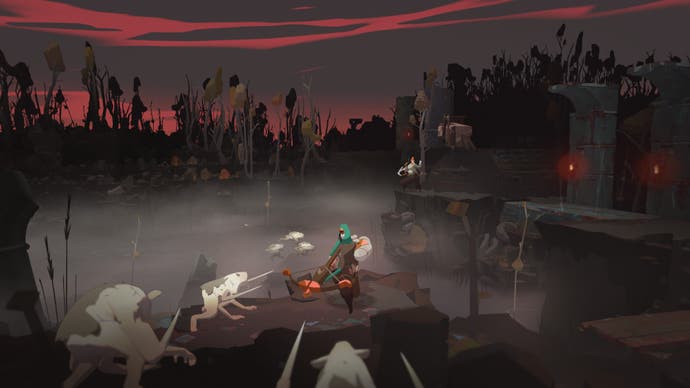
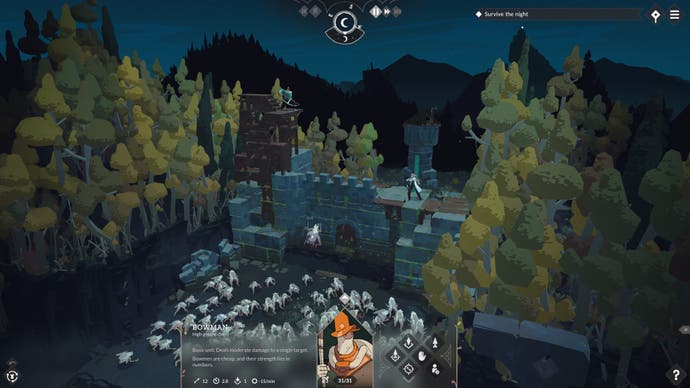
Cataclismo's building element feels like LEGO, and there's a touch of the sunshine splendour of Ensemble's old Age games to how workers emerge from logging camps and quarries, hauling goods to your town centre. But I remember the demo principally for the darkness clinging to the map edges, with thickly packed canopies of orange and brown that flatten dramatically into black silhouettes a handful of squares from each unit's field of view.
This forest can be hard to read, even from an elevated viewpoint. Zoom to finesse the construction of a bridge, and you'll often end up with a faceful of foliage, forcing you to spin the view and often, disorient yourself further. I frequently lost my bearings while guiding troops through the woodlands in the demo's first half. At the game's creepiest, I was reminded not of other strategy titles but of Darkwood, with its shifting, splintered vision cones. Building settlements frees the camera from those tangles, giving you clear proportions to navigate within, and a centre of gravity in the shape of your fortress citadel. The confusion you feel while weaving between the trunks is a provocation to do a bit of tacit QA on the setting. It's almost as though your real goal in this resentful, overgrown world were to render it more suitable for a strategy sim.
Strategy and tactics games lend themselves surprisingly well to horror not just because certain genre conventions, like fog of war, make fine ambient devices, but because strategy as a concept is fundamentally horrible. Strategising is dehumanising, even when you're playing a cosy village management sim, rather than some uber-militaristic 4X game. Whether fuelled by bloodshed or not, it's about dividing organisms by category, imposing borders, cancelling nuance and upping output - boiling everything and everybody down to the numbers and gauges on your menubar. Some horror-themed strategy or tactics games make a point of this in their stories. Dark Descent, for example, casts the player as an employee of the dastardly Weyland-Yutani corporation, with its triple-A marketing-esque slogan "building better worlds". Call me sadistic, but I would absolutely love it if you ended up pulling a Burke on all the squaddies under your command, fleeing the planet with a suitcase of xeno giblets to wow the shareholders, while everything self-destructs behind you.
Other strategy games handle the balefulness of strategy as a play practice more abstractly. Take 2019's Othercide for PC and consoles, a distant cousin of XCOM and a truly tormented work of quasi-Victorian noir, all slashing reds and bone whites, which expounds upon the nastiness of the concept of interchangeable units. Your troops, here, are clones or "Daughters" formed from the memories of the game's protagonist, the greatest warrior who ever lived. The only way of healing a Daughter is to sacrifice another, relinquishing her to the oily firmament that billows beneath the game's grid-based maps.

Maintaining your forces is thus an exercise in repeatedly liquefying yourself and your past - a displaced act of self-mutilation, of self-exploitation and willed amnesia, that is more thoughtful than it is garish, though it is certainly very garish. It's a brutal, overwhelming experience - you only get up to four Daughters per party, versus dozens of enemies, so as in XCOM, you must master the art of interrupting attacks and triggering bonus actions outside your turn to even the odds. But what makes it a horror game is how it makes you feel about yourself as commander.
It's a very different breed of sim, but I get the same queasy vibe from The Fabulous Fear Machine, due on PC this year. It's as whimsical and colourful as Othercide is dour and deathly, but comparably intent on characterising its player as deeply grotesque. The Machine of the title is one of those godawful animatronic fortune-tellers from antique fairgrounds. Pop a coin in and you gain access to an international psychic network that allows you to sow "fear seeds" in regions, introduce terrifying phenomena such as rains of frogs, and capitalise upon the resulting mass panic to achieve your villainous objectives, such as seizing control of the UK's pharmaceutical trade.
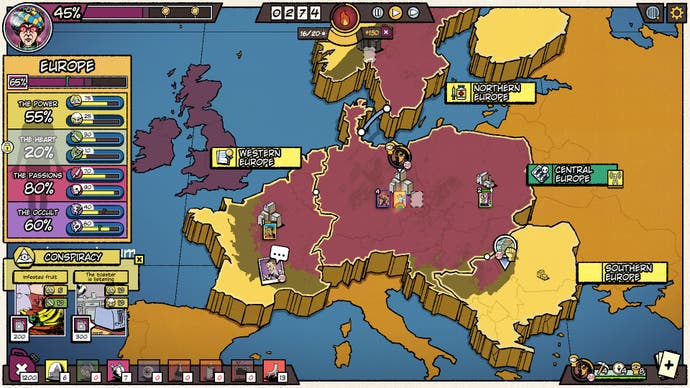

Unlike all the other games I've discussed here, The Fabulous Fear Machine more or less dispenses with the element of darkness. Each map is a 2D expanse of clean, comicbook hues and fonts, breezy and almost shadowless. But there's something in the mixture that revolts. The colour combinations are wrong somehow, like toilet cleaner slopped over custard. Their brightness is appalling - it suggests sleeplessness and paranoia and insatiability. This is a world that doesn't blink. The faces of your various secret agents gaze without expression. There's the sense that you, the cackling mastermind, are the real victim of the Machine, hovering on the brink of succumbing to the very hysteria you're trying to kindle.
